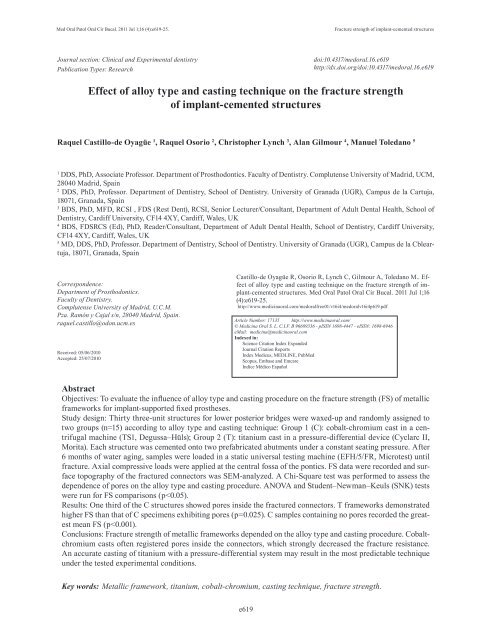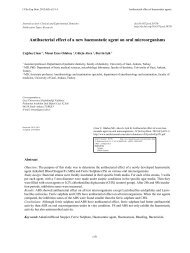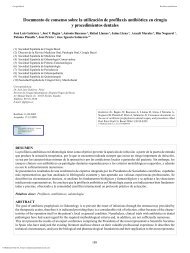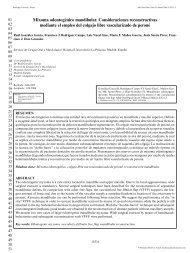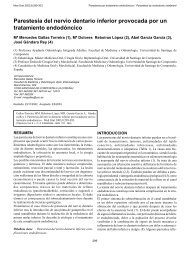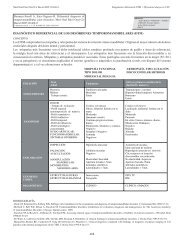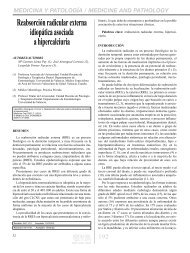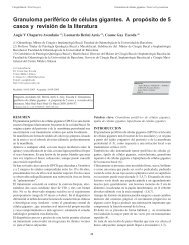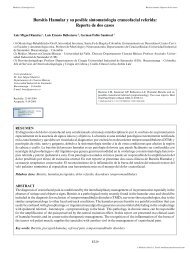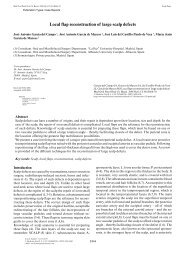Effect of alloy type and casting technique on the ... - Medicinaoral.com
Effect of alloy type and casting technique on the ... - Medicinaoral.com
Effect of alloy type and casting technique on the ... - Medicinaoral.com
You also want an ePaper? Increase the reach of your titles
YUMPU automatically turns print PDFs into web optimized ePapers that Google loves.
Med Oral Patol Oral Cir Bucal. 2011 Jul 1;16 (4):e619-25. Fracture strength <str<strong>on</strong>g>of</str<strong>on</strong>g> implant-cemented structures<br />
Journal secti<strong>on</strong>: Clinical <str<strong>on</strong>g>and</str<strong>on</strong>g> Experimental dentistry<br />
Publicati<strong>on</strong> Types: Research<br />
<str<strong>on</strong>g>Effect</str<strong>on</strong>g> <str<strong>on</strong>g>of</str<strong>on</strong>g> <str<strong>on</strong>g>alloy</str<strong>on</strong>g> <str<strong>on</strong>g>type</str<strong>on</strong>g> <str<strong>on</strong>g>and</str<strong>on</strong>g> <str<strong>on</strong>g>casting</str<strong>on</strong>g> <str<strong>on</strong>g>technique</str<strong>on</strong>g> <strong>on</strong> <strong>the</strong> fracture strength<br />
<str<strong>on</strong>g>of</str<strong>on</strong>g> implant-cemented structures<br />
Raquel Castillo-de Oyagüe 1 , Raquel Osorio 2 , Christopher Lynch 3 , Alan Gilmour 4 , Manuel Toledano 5<br />
1 DDS, PhD, Associate Pr<str<strong>on</strong>g>of</str<strong>on</strong>g>essor. Department <str<strong>on</strong>g>of</str<strong>on</strong>g> Prosthod<strong>on</strong>tics. Faculty <str<strong>on</strong>g>of</str<strong>on</strong>g> Dentistry. Complutense University <str<strong>on</strong>g>of</str<strong>on</strong>g> Madrid, UCM,<br />
28040 Madrid, Spain<br />
2 DDS, PhD, Pr<str<strong>on</strong>g>of</str<strong>on</strong>g>essor. Department <str<strong>on</strong>g>of</str<strong>on</strong>g> Dentistry, School <str<strong>on</strong>g>of</str<strong>on</strong>g> Dentistry. University <str<strong>on</strong>g>of</str<strong>on</strong>g> Granada (UGR), Campus de la Cartuja,<br />
18071, Granada, Spain<br />
3 BDS, PhD, MFD, RCSI , FDS (Rest Dent), RCSI, Senior Lecturer/C<strong>on</strong>sultant, Department <str<strong>on</strong>g>of</str<strong>on</strong>g> Adult Dental Health, School <str<strong>on</strong>g>of</str<strong>on</strong>g><br />
Dentistry, Cardiff University, CF14 4XY, Cardiff, Wales, UK<br />
4 BDS, FDSRCS (Ed), PhD, Reader/C<strong>on</strong>sultant, Department <str<strong>on</strong>g>of</str<strong>on</strong>g> Adult Dental Health, School <str<strong>on</strong>g>of</str<strong>on</strong>g> Dentistry, Cardiff University,<br />
CF14 4XY, Cardiff, Wales, UK<br />
5 MD, DDS, PhD, Pr<str<strong>on</strong>g>of</str<strong>on</strong>g>essor. Department <str<strong>on</strong>g>of</str<strong>on</strong>g> Dentistry, School <str<strong>on</strong>g>of</str<strong>on</strong>g> Dentistry. University <str<strong>on</strong>g>of</str<strong>on</strong>g> Granada (UGR), Campus de la Cblear-<br />
tuja, 18071, Granada, Spain<br />
Corresp<strong>on</strong>dence:<br />
Department <str<strong>on</strong>g>of</str<strong>on</strong>g> Prosthod<strong>on</strong>tics.<br />
Faculty <str<strong>on</strong>g>of</str<strong>on</strong>g> Dentistry.<br />
Complutense University <str<strong>on</strong>g>of</str<strong>on</strong>g> Madrid, U.C.M.<br />
Pza. Ramón y Cajal s/n, 28040 Madrid, Spain.<br />
raquel.castillo@od<strong>on</strong>.ucm.es<br />
Received: 05/06/2010<br />
Accepted: 25/07/2010<br />
Castillo-de Oyagüe R, Osorio R, Lynch C, Gilmour A, Toledano M.. <str<strong>on</strong>g>Effect</str<strong>on</strong>g><br />
<str<strong>on</strong>g>of</str<strong>on</strong>g> <str<strong>on</strong>g>alloy</str<strong>on</strong>g> <str<strong>on</strong>g>type</str<strong>on</strong>g> <str<strong>on</strong>g>and</str<strong>on</strong>g> <str<strong>on</strong>g>casting</str<strong>on</strong>g> <str<strong>on</strong>g>technique</str<strong>on</strong>g> <strong>on</strong> <strong>the</strong> fracture strength <str<strong>on</strong>g>of</str<strong>on</strong>g> implant-cemented<br />
structures. Med Oral Patol Oral Cir Bucal. 2011 Jul 1;16<br />
(4):e619-25.<br />
http://www.medicinaoral.<strong>com</strong>/medoralfree01/v16i4/medoralv16i4p619.pdf<br />
Article Number: 17135 http://www.medicinaoral.<strong>com</strong>/<br />
© Medicina Oral S. L. C.I.F. B 96689336 - pISSN 1698-4447 - eISSN: 1698-6946<br />
eMail: medicina@medicinaoral.<strong>com</strong><br />
Indexed in:<br />
Science Citati<strong>on</strong> Index Exp<str<strong>on</strong>g>and</str<strong>on</strong>g>ed<br />
Journal Citati<strong>on</strong> Reports<br />
Index Medicus, MEDLINE, PubMed<br />
Scopus, Embase <str<strong>on</strong>g>and</str<strong>on</strong>g> Emcare<br />
Indice Médico Español<br />
Abstract<br />
Objectives: To evaluate <strong>the</strong> influence <str<strong>on</strong>g>of</str<strong>on</strong>g> <str<strong>on</strong>g>alloy</str<strong>on</strong>g> <str<strong>on</strong>g>type</str<strong>on</strong>g> <str<strong>on</strong>g>and</str<strong>on</strong>g> <str<strong>on</strong>g>casting</str<strong>on</strong>g> procedure <strong>on</strong> <strong>the</strong> fracture strength (FS) <str<strong>on</strong>g>of</str<strong>on</strong>g> metallic<br />
frameworks for implant-supported fixed pros<strong>the</strong>ses.<br />
Study design: Thirty three-unit structures for lower posterior bridges were waxed-up <str<strong>on</strong>g>and</str<strong>on</strong>g> r<str<strong>on</strong>g>and</str<strong>on</strong>g>omly assigned to<br />
two groups (n=15) according to <str<strong>on</strong>g>alloy</str<strong>on</strong>g> <str<strong>on</strong>g>type</str<strong>on</strong>g> <str<strong>on</strong>g>and</str<strong>on</strong>g> <str<strong>on</strong>g>casting</str<strong>on</strong>g> <str<strong>on</strong>g>technique</str<strong>on</strong>g>: Group 1 (C): cobalt-chromium cast in a centrifugal<br />
machine (TS1, Degussa–Hüls); Group 2 (T): titanium cast in a pressure-differential device (Cyclarc II,<br />
Morita). Each structure was cemented <strong>on</strong>to two prefabricated abutments under a c<strong>on</strong>stant seating pressure. After<br />
6 m<strong>on</strong>ths <str<strong>on</strong>g>of</str<strong>on</strong>g> water aging, samples were loaded in a static universal testing machine (EFH/5/FR, Microtest) until<br />
fracture. Axial <strong>com</strong>pressive loads were applied at <strong>the</strong> central fossa <str<strong>on</strong>g>of</str<strong>on</strong>g> <strong>the</strong> p<strong>on</strong>tics. FS data were recorded <str<strong>on</strong>g>and</str<strong>on</strong>g> surface<br />
topography <str<strong>on</strong>g>of</str<strong>on</strong>g> <strong>the</strong> fractured c<strong>on</strong>nectors was SEM-analyzed. A Chi-Square test was performed to assess <strong>the</strong><br />
dependence <str<strong>on</strong>g>of</str<strong>on</strong>g> pores <strong>on</strong> <strong>the</strong> <str<strong>on</strong>g>alloy</str<strong>on</strong>g> <str<strong>on</strong>g>type</str<strong>on</strong>g> <str<strong>on</strong>g>and</str<strong>on</strong>g> <str<strong>on</strong>g>casting</str<strong>on</strong>g> procedure. ANOVA <str<strong>on</strong>g>and</str<strong>on</strong>g> Student–Newman–Keuls (SNK) tests<br />
were run for FS <strong>com</strong>paris<strong>on</strong>s (p
Med Oral Patol Oral Cir Bucal. 2011 Jul 1;16 (4):e619-25. Fracture strength <str<strong>on</strong>g>of</str<strong>on</strong>g> implant-cemented structures<br />
Introducti<strong>on</strong><br />
The biomechanical behavior <str<strong>on</strong>g>of</str<strong>on</strong>g> implant-retained restorati<strong>on</strong>s<br />
may be <strong>com</strong>promised by, am<strong>on</strong>gst o<strong>the</strong>rs, accumulated<br />
errors in <strong>the</strong> <str<strong>on</strong>g>casting</str<strong>on</strong>g> procedure (1). Cast frameworks<br />
may suffer distorti<strong>on</strong>, marginal misfit, <str<strong>on</strong>g>and</str<strong>on</strong>g>/or airentrapment,<br />
thus enhancing <strong>the</strong> effects <str<strong>on</strong>g>of</str<strong>on</strong>g> mechanical<br />
fatigue (2, 3). Interacti<strong>on</strong>s <str<strong>on</strong>g>of</str<strong>on</strong>g> such factors might lead<br />
to catastrophic failures, ei<strong>the</strong>r under repeated loading,<br />
or after stress c<strong>on</strong>centrati<strong>on</strong>s exceeding <strong>the</strong> ultimate<br />
strength <str<strong>on</strong>g>of</str<strong>on</strong>g> <strong>the</strong> materials. Although little scientific data<br />
have been published <strong>on</strong> <strong>the</strong> performance <str<strong>on</strong>g>of</str<strong>on</strong>g> cobaltchromium<br />
<str<strong>on</strong>g>alloy</str<strong>on</strong>g>s for implant-pros<strong>the</strong>tic applicati<strong>on</strong>s (4),<br />
cobalt-chromium structures are <strong>the</strong> most widely used<br />
in implant dentistry due to <strong>the</strong>ir high fracture strength,<br />
elastic module <str<strong>on</strong>g>and</str<strong>on</strong>g> hardness (5), absence <str<strong>on</strong>g>of</str<strong>on</strong>g> potential allergenic<br />
<str<strong>on</strong>g>and</str<strong>on</strong>g> carcinogenetic <strong>com</strong>p<strong>on</strong>ents (such as nickel<br />
<str<strong>on</strong>g>and</str<strong>on</strong>g> beryllium) <str<strong>on</strong>g>and</str<strong>on</strong>g> low cost (6). In c<strong>on</strong>trast, titanium<br />
has be<strong>com</strong>e more popular in implant-supported superstructures<br />
due to its superior strength-to-weight ratio,<br />
recognized bio<strong>com</strong>patibility <str<strong>on</strong>g>and</str<strong>on</strong>g> corrosi<strong>on</strong> resistance (1,<br />
6, 7). Notwithst<str<strong>on</strong>g>and</str<strong>on</strong>g>ing <strong>the</strong> difficulty <str<strong>on</strong>g>of</str<strong>on</strong>g> <str<strong>on</strong>g>casting</str<strong>on</strong>g> titanium<br />
<str<strong>on</strong>g>alloy</str<strong>on</strong>g>s, usually involving special investment materials,<br />
high melting points <str<strong>on</strong>g>and</str<strong>on</strong>g> an inert atmosphere (1), little<br />
research has been c<strong>on</strong>ducted c<strong>on</strong>cerning <strong>the</strong> precisi<strong>on</strong><br />
<str<strong>on</strong>g>of</str<strong>on</strong>g> recently-marketed <str<strong>on</strong>g>casting</str<strong>on</strong>g> units for titanium in <strong>com</strong>paris<strong>on</strong><br />
with traditi<strong>on</strong>al centrifugal devices (7, 8).<br />
Despite <strong>the</strong> accuracy <str<strong>on</strong>g>of</str<strong>on</strong>g> CAD/CAM systems for fabricating<br />
metallic structures, <str<strong>on</strong>g>casting</str<strong>on</strong>g> technologies c<strong>on</strong>tinue to<br />
be more frequently used largely because <str<strong>on</strong>g>of</str<strong>on</strong>g> ec<strong>on</strong>omic<br />
reas<strong>on</strong>s (1). However, very few investigati<strong>on</strong>s have focused<br />
<strong>on</strong> <strong>the</strong> inherent physical properties <str<strong>on</strong>g>of</str<strong>on</strong>g> differently<br />
processed frameworks (9, 10). Given <strong>the</strong> <strong>com</strong>plexity in<br />
achieving a perfect cast with current technologies (2),<br />
this study aimed to indirectly evaluate <strong>the</strong> castability<br />
Table 1. Chemical <strong>com</strong>positi<strong>on</strong> <str<strong>on</strong>g>of</str<strong>on</strong>g> <strong>the</strong> <str<strong>on</strong>g>alloy</str<strong>on</strong>g>s tested in <strong>the</strong> study.<br />
Cobalt-chromium<br />
e620<br />
<str<strong>on</strong>g>of</str<strong>on</strong>g> cobalt-chromium <str<strong>on</strong>g>and</str<strong>on</strong>g> pure titanium by determining<br />
<strong>the</strong> fracture strength <str<strong>on</strong>g>and</str<strong>on</strong>g> interfacial morphology <str<strong>on</strong>g>of</str<strong>on</strong>g> <strong>the</strong><br />
fractured surfaces <str<strong>on</strong>g>of</str<strong>on</strong>g> cast superstructures. Moreover, no<br />
previous research has been carried out <strong>on</strong> this topic.<br />
The null hypo<strong>the</strong>sis tested was that <strong>the</strong>re are no differences<br />
in <strong>the</strong> fracture resistance <str<strong>on</strong>g>and</str<strong>on</strong>g> topographic patterns<br />
<str<strong>on</strong>g>of</str<strong>on</strong>g> <strong>the</strong> fracture fragments <str<strong>on</strong>g>of</str<strong>on</strong>g> implant-bridge cemented<br />
frameworks regardless <strong>the</strong> <str<strong>on</strong>g>alloy</str<strong>on</strong>g> <str<strong>on</strong>g>type</str<strong>on</strong>g> (cobalt-chromium<br />
vs. pure titanium) <str<strong>on</strong>g>and</str<strong>on</strong>g> <strong>the</strong>ir associated investing <str<strong>on</strong>g>and</str<strong>on</strong>g><br />
<str<strong>on</strong>g>casting</str<strong>on</strong>g> <str<strong>on</strong>g>technique</str<strong>on</strong>g>s (centrifugal cast vs. pressure–differential<br />
system, respectively).<br />
Materials <str<strong>on</strong>g>and</str<strong>on</strong>g> Methods<br />
-Experimental design <str<strong>on</strong>g>and</str<strong>on</strong>g> <str<strong>on</strong>g>casting</str<strong>on</strong>g> <str<strong>on</strong>g>technique</str<strong>on</strong>g>s<br />
Two c<strong>on</strong>ical titanium abutments for cemented restorati<strong>on</strong>s<br />
(height: 6 mm) (ref. PCM7013, Implant Microdent<br />
System, Barcel<strong>on</strong>a, Spain) were c<strong>on</strong>nected to <strong>the</strong>ir corresp<strong>on</strong>ding<br />
implant replicas (diameter: 3.8 mm) <str<strong>on</strong>g>and</str<strong>on</strong>g><br />
torqued to 35 Ncm. Abutments were fixed into a special<br />
aluminum platform using stainless steel screws <str<strong>on</strong>g>and</str<strong>on</strong>g><br />
<str<strong>on</strong>g>type</str<strong>on</strong>g> IV plaster. Two series <str<strong>on</strong>g>of</str<strong>on</strong>g> structures were waxed<br />
<str<strong>on</strong>g>and</str<strong>on</strong>g> cast with different <str<strong>on</strong>g>alloy</str<strong>on</strong>g>s. Chemical <strong>com</strong>positi<strong>on</strong> <str<strong>on</strong>g>of</str<strong>on</strong>g><br />
<strong>the</strong> tested metals is described in Table 1. The frameworks<br />
c<strong>on</strong>sisted <str<strong>on</strong>g>of</str<strong>on</strong>g> three-unit posterior-lower bridgestructures<br />
for implant-cemented pros<strong>the</strong>ses with an<br />
intermediate p<strong>on</strong>tic (spanning <strong>the</strong> first premolar to <strong>the</strong><br />
first molar). Wax patterns (Bego–Dental Wax, Bremen,<br />
Germany) were prepared over burnout <str<strong>on</strong>g>casting</str<strong>on</strong>g> copings<br />
(ref. CCM7011 – Implant Microdent System, Barcel<strong>on</strong>a,<br />
Spain), <str<strong>on</strong>g>and</str<strong>on</strong>g> r<str<strong>on</strong>g>and</str<strong>on</strong>g>omly assigned to two groups (n=15<br />
each).<br />
Group 1 (C) was cast using a base metal <str<strong>on</strong>g>alloy</str<strong>on</strong>g> <str<strong>on</strong>g>of</str<strong>on</strong>g> white<br />
cobalt-chromium for ceramics (IPS d.SIGN30, Ivoclar<br />
Vivadent, Madrid, Spain). Patterns were invested in<br />
Dental <str<strong>on</strong>g>alloy</str<strong>on</strong>g>s Compositi<strong>on</strong> [weight (wt) %)]<br />
(IPS d.SIGN30, IvoclarVivadent)<br />
Pure <str<strong>on</strong>g>type</str<strong>on</strong>g> II titanium<br />
(Titan 15, Morita)<br />
cobalt (60.2 wt %);<br />
chromium (30.1 wt %);<br />
gallium (3.9 wt %);<br />
niobium (3.2 wt %);<br />
traces <str<strong>on</strong>g>of</str<strong>on</strong>g>: silicium, molybdenum,<br />
bor<strong>on</strong>, ir<strong>on</strong>, aluminum <str<strong>on</strong>g>and</str<strong>on</strong>g><br />
lithium.<br />
titanium (99,794 wt %);<br />
traces <str<strong>on</strong>g>of</str<strong>on</strong>g>: oxygen, ferrum, carb<strong>on</strong>um,<br />
nitrogen <str<strong>on</strong>g>and</str<strong>on</strong>g> hydrogen.
Med Oral Patol Oral Cir Bucal. 2011 Jul 1;16 (4):e619-25. Fracture strength <str<strong>on</strong>g>of</str<strong>on</strong>g> implant-cemented structures<br />
cylinders without a metallic ring, using a phosphatebased<br />
improved plaster (Deguvest–Impact, Degussa–<br />
Hüls, Hanau, Germany). The cast was performed in a<br />
centrifugal machine (TS1, Degussa–Hüls, Frankfurt,<br />
Germany) at 1220 ºC.<br />
Group 2 (T) was cast with <str<strong>on</strong>g>type</str<strong>on</strong>g> II pure titanium base<br />
metal for ceramics (Titan 15, J. Morita, Kyoto, Japan).<br />
An alumina-magnesia-system was used as investment<br />
material (Titavest CB, J. Morita, Kyoto, Japan). The<br />
“A+C” mode was programmed in <strong>the</strong> pressure-differential<br />
machine (Cyclarc II, J. Morita, Kyoto, Japan). The<br />
<str<strong>on</strong>g>casting</str<strong>on</strong>g> device c<strong>on</strong>sisted <strong>on</strong> two-chamber pressure/vacuum<br />
system that smelts <strong>the</strong> titanium at <strong>the</strong> temperature<br />
<str<strong>on</strong>g>of</str<strong>on</strong>g> 1700 ºC with a voltaic arc under an inert arg<strong>on</strong> atmosphere.All<br />
bridge structures were carefully removed<br />
<str<strong>on</strong>g>and</str<strong>on</strong>g> s<str<strong>on</strong>g>and</str<strong>on</strong>g>blasted with 50 µm aluminum-oxide particles<br />
for 10 s at a working distance <str<strong>on</strong>g>of</str<strong>on</strong>g> 5 mm <str<strong>on</strong>g>and</str<strong>on</strong>g> a pressure<br />
<str<strong>on</strong>g>of</str<strong>on</strong>g> 60–100 psi.<br />
-Luting procedure<br />
Cementati<strong>on</strong> was performed to simulate clinical c<strong>on</strong>diti<strong>on</strong>s.<br />
Metallic frameworks were luted to <strong>the</strong>ir respective<br />
abutments with Temp B<strong>on</strong>d (Kerr, Oklahoma, USA). A<br />
special clamp was designed to maintain a c<strong>on</strong>stant seating<br />
pressure <str<strong>on</strong>g>of</str<strong>on</strong>g> 25 Ncm for 4 min. Two hexag<strong>on</strong>-shaped<br />
relieves (fitting perfectly into <strong>the</strong> abutment’s hexag<strong>on</strong>s<br />
<str<strong>on</strong>g>and</str<strong>on</strong>g> duplicating <strong>the</strong>ir positi<strong>on</strong> in <strong>the</strong> initial metallic<br />
support) were incorporated <strong>on</strong> <strong>the</strong> clamp basis. Axial<br />
surfaces <str<strong>on</strong>g>of</str<strong>on</strong>g> <strong>the</strong> abutments placed in <strong>the</strong> clamp were varnished<br />
with a thin cement layer before inserting each<br />
bridge structure. The clamp press was unscrewed until<br />
it c<strong>on</strong>tacted with <strong>the</strong> specimen’s occlusal surface. The<br />
upper screw that c<strong>on</strong>trolled <strong>the</strong> press was fitted with<br />
a torque driver tool for implant applicati<strong>on</strong>s (Defc<strong>on</strong><br />
I–72000, Impladent, Barcel<strong>on</strong>a, Spain). B<strong>on</strong>ded specimens<br />
were stored in distilled water at 37 °C <str<strong>on</strong>g>and</str<strong>on</strong>g> 100 %<br />
humidity for six m<strong>on</strong>ths before Fracture Strength (FS)<br />
testing.<br />
-Fracture strength test<br />
Based <strong>on</strong> a previous FS protocol that aimed to simulate<br />
in vivo c<strong>on</strong>diti<strong>on</strong>s (11), thirty custom-made blocks<br />
<str<strong>on</strong>g>of</str<strong>on</strong>g> <strong>com</strong>posite material (Tetric Evo Ceram, A3, batch<br />
no J27435, Ivoclar–Vivadent; Schaan, Liechtenstein)<br />
were fabricated using a cubic-shaped silic<strong>on</strong> mould.<br />
The implant-replicas <str<strong>on</strong>g>of</str<strong>on</strong>g> every bridge framework were<br />
embedded inside a <strong>com</strong>posite cube. This procedure was<br />
carried out to reproduce <strong>the</strong> mean elastic module (E)<br />
reported for trabecular human b<strong>on</strong>e [E (Tetric) =15,1 +/- 0.8<br />
GPa (12); E (B<strong>on</strong>e) = 13.5 +/- 2.0 GPa (13)]. Composite increments<br />
were c<strong>on</strong>densed around <strong>the</strong> implant-replicas<br />
with a clean plastic instrument to avoid c<strong>on</strong>taminati<strong>on</strong>,<br />
<str<strong>on</strong>g>and</str<strong>on</strong>g> light-cured for 40 s (BluePhase, Ivoclar–Vivadent,<br />
output: 600 mmW/cm 2 ). Once removed from <strong>the</strong> mould,<br />
an extra 40 s irradiati<strong>on</strong> was performed <strong>on</strong> <strong>the</strong> porti<strong>on</strong>s<br />
<str<strong>on</strong>g>of</str<strong>on</strong>g> <strong>the</strong> cubes that had previously been in c<strong>on</strong>tact with<br />
<strong>the</strong> silic<strong>on</strong>e patterns. After 24h, all samples were test-<br />
e621<br />
ed for fracture strength (FS) in a <strong>com</strong>puter-supported<br />
universal testing machine (EFH/5/FR, Microtest S.A.;<br />
Madrid, Spain) at a cross-head speed <str<strong>on</strong>g>of</str<strong>on</strong>g> 1 mm/min. The<br />
<strong>com</strong>posite cubes c<strong>on</strong>taining <strong>the</strong> bridge structures were<br />
placed <str<strong>on</strong>g>and</str<strong>on</strong>g> fixed to <strong>the</strong> basis <str<strong>on</strong>g>of</str<strong>on</strong>g> <strong>the</strong> testing device. Axial<br />
<strong>com</strong>pressive static loads were applied at <strong>the</strong> occlusal<br />
fossa <str<strong>on</strong>g>of</str<strong>on</strong>g> <strong>the</strong> p<strong>on</strong>tics. Loading was applied until sp<strong>on</strong>taneous<br />
rupture, <str<strong>on</strong>g>and</str<strong>on</strong>g> failure forces were recorded with <strong>the</strong><br />
<strong>com</strong>puter s<str<strong>on</strong>g>of</str<strong>on</strong>g>tware (SCM4000, Microtest S.A.; Madrid,<br />
Spain). The fracture initiati<strong>on</strong> point was determined by<br />
a sudden drop in <strong>the</strong> loading curve <str<strong>on</strong>g>and</str<strong>on</strong>g> perceived as a<br />
loud cracking sound. Fracture strength values (FS) were<br />
expressed in Newt<strong>on</strong> (N). Both retainers <str<strong>on</strong>g>of</str<strong>on</strong>g> every bridge<br />
structure were numbered using an indelible marking<br />
pen to identify <strong>the</strong> <str<strong>on</strong>g>alloy</str<strong>on</strong>g> group <str<strong>on</strong>g>and</str<strong>on</strong>g> specimen. Once<br />
retrieved from <strong>the</strong> <strong>com</strong>posite cubes <str<strong>on</strong>g>and</str<strong>on</strong>g> implant replicas,<br />
<strong>the</strong> fractured pieces still b<strong>on</strong>ded to <strong>the</strong> abutments<br />
were gently ultras<strong>on</strong>icated for 1h <str<strong>on</strong>g>and</str<strong>on</strong>g> air dried.<br />
-Fracture pattern analysis<br />
Failure modes were evaluated by a single operator under<br />
an optical microscope (BH–2 Olympus; Tokyo,<br />
Japan) at 60× magnificati<strong>on</strong>s, <str<strong>on</strong>g>and</str<strong>on</strong>g> classified as ductile<br />
(plastic deformati<strong>on</strong> <str<strong>on</strong>g>and</str<strong>on</strong>g> tearing <str<strong>on</strong>g>of</str<strong>on</strong>g> metal) or brittle (no<br />
significant plastic deformati<strong>on</strong> showing flat surfaces at<br />
<strong>the</strong> fracture line). Percentages <str<strong>on</strong>g>of</str<strong>on</strong>g> fractured structures<br />
c<strong>on</strong>taining pores were recorded per tested group.<br />
-Statistical procedures<br />
Normal fracture strength data distributi<strong>on</strong> was c<strong>on</strong>firmed<br />
by Kolmogorov–Smirnov test, <str<strong>on</strong>g>and</str<strong>on</strong>g> homogeneity<br />
<str<strong>on</strong>g>of</str<strong>on</strong>g> variances was verified according to Levene’s test. A<br />
Chi-Square test was performed to assess <strong>the</strong> dependence<br />
<str<strong>on</strong>g>of</str<strong>on</strong>g> pores <strong>on</strong> <strong>the</strong> <str<strong>on</strong>g>alloy</str<strong>on</strong>g> <str<strong>on</strong>g>type</str<strong>on</strong>g> <str<strong>on</strong>g>and</str<strong>on</strong>g> <str<strong>on</strong>g>casting</str<strong>on</strong>g> procedure.<br />
One-way analysis <str<strong>on</strong>g>of</str<strong>on</strong>g> variance (ANOVA) <str<strong>on</strong>g>and</str<strong>on</strong>g> Student–<br />
Newman–Keuls (SNK) tests were run for FS <strong>com</strong>paris<strong>on</strong>s<br />
c<strong>on</strong>sidering <strong>the</strong> pore presence as a discriminating<br />
factor. The significance level was set at α=0.05.<br />
-Scanning Electr<strong>on</strong> Microscopy (SEM) evaluati<strong>on</strong><br />
Surface topography <str<strong>on</strong>g>of</str<strong>on</strong>g> representative fractured c<strong>on</strong>nectors<br />
was assessed using scanning electr<strong>on</strong> microscopy<br />
(SEM, JSM–6400, Jeol, Tokyo, Japan). Specific areas<br />
were explored, focusing with different magnificati<strong>on</strong>s<br />
(from 20× to 1500×) to better analyze <strong>the</strong> fractured c<strong>on</strong>nectors’<br />
surfaces.<br />
Results<br />
Mean <str<strong>on</strong>g>and</str<strong>on</strong>g> st<str<strong>on</strong>g>and</str<strong>on</strong>g>ard deviati<strong>on</strong> fracture strength (FS)<br />
values recorded in <strong>the</strong> tested groups are summarized in<br />
Table 2. The <str<strong>on</strong>g>alloy</str<strong>on</strong>g> <str<strong>on</strong>g>type</str<strong>on</strong>g> <str<strong>on</strong>g>and</str<strong>on</strong>g> its associated investing <str<strong>on</strong>g>and</str<strong>on</strong>g><br />
<str<strong>on</strong>g>casting</str<strong>on</strong>g> <str<strong>on</strong>g>technique</str<strong>on</strong>g> significantly affected FS <str<strong>on</strong>g>of</str<strong>on</strong>g> metallic<br />
frameworks (p
Med Oral Patol Oral Cir Bucal. 2011 Jul 1;16 (4):e619-25. Fracture strength <str<strong>on</strong>g>of</str<strong>on</strong>g> implant-cemented structures<br />
Fig. 1. A) SEM micrographs <str<strong>on</strong>g>of</str<strong>on</strong>g> a cobalt-chromium fractured c<strong>on</strong>nector<br />
c<strong>on</strong>taining a large pore. A stepped <str<strong>on</strong>g>and</str<strong>on</strong>g> rough topography<br />
coexists with a smoo<strong>the</strong>r surface around <strong>the</strong> hole. (a) 25× magnificati<strong>on</strong>s;<br />
20 kV; bar 2 mm.<br />
Fig. 1. B) 100× magnificati<strong>on</strong>s; 20 kV; bar 500 µm.<br />
Fig. 1. C) 500× magnificati<strong>on</strong>s; 20 kV; bar 100 µm.<br />
e622<br />
Table 2. Percentages <str<strong>on</strong>g>of</str<strong>on</strong>g> pores inside <strong>the</strong> bridge c<strong>on</strong>nectors, <str<strong>on</strong>g>and</str<strong>on</strong>g> mean<br />
(SD) values <str<strong>on</strong>g>of</str<strong>on</strong>g> fracture resistance (N) recorded in <strong>the</strong> experimental<br />
groups, are displayed in <strong>the</strong> table.<br />
Pore presence (%) <str<strong>on</strong>g>and</str<strong>on</strong>g> Fracture Resistance (N)<br />
Alloy <str<strong>on</strong>g>type</str<strong>on</strong>g> <str<strong>on</strong>g>and</str<strong>on</strong>g><br />
<str<strong>on</strong>g>casting</str<strong>on</strong>g> process<br />
Cobalt-chromium<br />
(Centrifugal <str<strong>on</strong>g>casting</str<strong>on</strong>g>)<br />
Titanium<br />
(Pressure-differential<br />
<str<strong>on</strong>g>casting</str<strong>on</strong>g>)<br />
Pore presence Fracture resistance<br />
(% <str<strong>on</strong>g>of</str<strong>on</strong>g> structures) Mean (SD)<br />
Yes 33.4% 3 407.2 (408.53) c<br />
No 66.6% 8 361.7 (672.99) b<br />
Yes 0% –<br />
No 100% 4 308.14 (776.56) a<br />
(p=0.025). However, C samples c<strong>on</strong>taining no pores recorded<br />
<strong>the</strong> greatest mean FS (p
Med Oral Patol Oral Cir Bucal. 2011 Jul 1;16 (4):e619-25. Fracture strength <str<strong>on</strong>g>of</str<strong>on</strong>g> implant-cemented structures<br />
Fig. 2. A) SEM images <str<strong>on</strong>g>of</str<strong>on</strong>g> a cobalt-chromium fractured c<strong>on</strong>nector<br />
showing no porosities. An unparallel striated pattern with a fibrous<br />
appearance at different fracture levels is evident. (a) 20× magnificati<strong>on</strong>s;<br />
20 kV; bar 2 mm.<br />
e623<br />
Fig. 2. B) 500× magnificati<strong>on</strong>s; 20 kV; bar 100 µm.<br />
Fig. 2. C) 1500× magnificati<strong>on</strong>s; 20 kV; bar 30 µm. Fig. 3. A) SEM micrographs <str<strong>on</strong>g>of</str<strong>on</strong>g> a titanium fractured c<strong>on</strong>nector. A<br />
higher density <str<strong>on</strong>g>and</str<strong>on</strong>g> flatter surface is noticeable. (a) 20× magnificati<strong>on</strong>s;<br />
20 kV; bar 2 mm.<br />
Fig. 3. B) 500× magnificati<strong>on</strong>s; 20 kV; bar 100 µm. Fig. 3. C) 1500× magnificati<strong>on</strong>s; 20 kV; bar 30 µm.
Med Oral Patol Oral Cir Bucal. 2011 Jul 1;16 (4):e619-25. Fracture strength <str<strong>on</strong>g>of</str<strong>on</strong>g> implant-cemented structures<br />
Discussi<strong>on</strong><br />
A number <str<strong>on</strong>g>of</str<strong>on</strong>g> <str<strong>on</strong>g>alloy</str<strong>on</strong>g>s may be chosen for fabricating implant-supported<br />
cemented superstructures. However,<br />
c<strong>on</strong>cerns still remain regarding <strong>the</strong> identificati<strong>on</strong> <str<strong>on</strong>g>of</str<strong>on</strong>g><br />
<strong>the</strong> best <str<strong>on</strong>g>alloy</str<strong>on</strong>g> <strong>com</strong>positi<strong>on</strong> <str<strong>on</strong>g>and</str<strong>on</strong>g> <str<strong>on</strong>g>casting</str<strong>on</strong>g> technology (2).<br />
The purpose <str<strong>on</strong>g>of</str<strong>on</strong>g> <strong>the</strong> present research was to <strong>com</strong>pare<br />
two dental <str<strong>on</strong>g>alloy</str<strong>on</strong>g>s according to <strong>the</strong>ir required <str<strong>on</strong>g>casting</str<strong>on</strong>g><br />
methods, by assessing <strong>the</strong> ultimate load <str<strong>on</strong>g>and</str<strong>on</strong>g> interfacial<br />
morphology <str<strong>on</strong>g>of</str<strong>on</strong>g> <strong>the</strong> fractured fragments <str<strong>on</strong>g>of</str<strong>on</strong>g> bridge<br />
frames luted <strong>on</strong>to two implant abutments. The findings<br />
<str<strong>on</strong>g>of</str<strong>on</strong>g> this study require <strong>the</strong> rejecti<strong>on</strong> <str<strong>on</strong>g>of</str<strong>on</strong>g> <strong>the</strong> null hypo<strong>the</strong>sis;<br />
since differences in fracture strength <str<strong>on</strong>g>and</str<strong>on</strong>g> topographic<br />
patterns were recorded (Table 2) (Figs. 1–3). The cobalt-chromium<br />
<str<strong>on</strong>g>alloy</str<strong>on</strong>g> cast in a centrifugal machine resulted<br />
in <strong>the</strong> least predictable opti<strong>on</strong> in terms <str<strong>on</strong>g>of</str<strong>on</strong>g> fracture<br />
strength due to <strong>the</strong> remarkable frequency <str<strong>on</strong>g>of</str<strong>on</strong>g> air entrapment<br />
inside <strong>the</strong> c<strong>on</strong>nectors. Despite <strong>the</strong> highest mean<br />
fracture resistance being recorded for cobalt-chromium<br />
structures c<strong>on</strong>taining no pores, porosity defects detected<br />
in <strong>on</strong>e third <str<strong>on</strong>g>of</str<strong>on</strong>g> <strong>the</strong> cobalt-chromium frames (Fig.<br />
1) hampered <strong>the</strong>ir fracture strength when <strong>com</strong>pared to<br />
that <str<strong>on</strong>g>of</str<strong>on</strong>g> <strong>the</strong> titanium structures (Table 2). N<strong>on</strong>e<strong>the</strong>less,<br />
all <strong>the</strong> specimens tested reached greater ultimate loads<br />
than <strong>the</strong> mean occlusal forces reported for implant-supported<br />
pros<strong>the</strong>ses in <strong>the</strong> oral cavity (144N) (9). Even <strong>the</strong><br />
maximum expectable forces –that occur in <strong>the</strong> molar<br />
regi<strong>on</strong> in cases <str<strong>on</strong>g>of</str<strong>on</strong>g> parafuncti<strong>on</strong>al activity such as bruxism–,<br />
range from 500 N to 880 N (14).<br />
Wictorin et al. (15) analyzed <strong>the</strong> frequency <str<strong>on</strong>g>and</str<strong>on</strong>g> site<br />
<str<strong>on</strong>g>of</str<strong>on</strong>g> internal defects in sixty-six cobalt-chromium cast<br />
frameworks by using a n<strong>on</strong>-destructive X-ray method.<br />
As a result, 294 pores or cracks were recorded in sixtyfour<br />
structures. Surprisingly, very little research <strong>on</strong> this<br />
topic has been made since <strong>the</strong>n. Minor percentages <str<strong>on</strong>g>of</str<strong>on</strong>g><br />
pores were detected in <strong>the</strong> present study even when a<br />
SEM was used. Improvements in investing <str<strong>on</strong>g>and</str<strong>on</strong>g> <str<strong>on</strong>g>casting</str<strong>on</strong>g><br />
technologies in <strong>the</strong> last decades may be explaining reas<strong>on</strong>s.<br />
Jang et al. (7) obtained <strong>com</strong>parable porosity for both<br />
cobalt-chromium <str<strong>on</strong>g>and</str<strong>on</strong>g> titanium in cast structures for removable<br />
partial dentures. Obvious differences c<strong>on</strong>cerning<br />
<strong>the</strong> frameworks’ design <str<strong>on</strong>g>and</str<strong>on</strong>g> <strong>the</strong> <str<strong>on</strong>g>casting</str<strong>on</strong>g> devices used<br />
e624<br />
for cobalt-chromium (Optivest, Degussa) <str<strong>on</strong>g>and</str<strong>on</strong>g> for titanium<br />
(Rematitan, Dentaurum) make data <strong>com</strong>paris<strong>on</strong><br />
difficult. Bessing <str<strong>on</strong>g>and</str<strong>on</strong>g> Bergman (16) tested <strong>the</strong> castability<br />
<str<strong>on</strong>g>of</str<strong>on</strong>g> pure titanium in different machines, so that <strong>the</strong><br />
most accurate structures were those cast in <strong>the</strong> Cyclarc<br />
pressure-differential device. These findings may support<br />
<strong>the</strong> predictability <str<strong>on</strong>g>of</str<strong>on</strong>g> results obtained in <strong>the</strong> present<br />
experiment for <strong>the</strong> titanium group.<br />
Nowadays it can be argued from <strong>the</strong> infrequency <str<strong>on</strong>g>of</str<strong>on</strong>g><br />
catastrophic metal failures as a result <str<strong>on</strong>g>of</str<strong>on</strong>g> chewing or<br />
clenching forces, that <strong>the</strong> problem is no l<strong>on</strong>ger serious<br />
(17). However, lesser metal fatigue issues, <str<strong>on</strong>g>of</str<strong>on</strong>g>ten unrecognized,<br />
such as plastic distorti<strong>on</strong>s in presence <str<strong>on</strong>g>of</str<strong>on</strong>g><br />
porosity defects can promote cracking <str<strong>on</strong>g>of</str<strong>on</strong>g> <strong>the</strong> veneering<br />
ceramics (18). Depending <strong>on</strong> <strong>the</strong> locati<strong>on</strong>, amount,<br />
distributi<strong>on</strong> <str<strong>on</strong>g>and</str<strong>on</strong>g> diameter size <str<strong>on</strong>g>of</str<strong>on</strong>g> <strong>the</strong> inner porosities a<br />
fracture <str<strong>on</strong>g>of</str<strong>on</strong>g> <strong>the</strong> metallic substructure itself may occur.<br />
When <strong>the</strong> defects are situated in a critical regi<strong>on</strong> – i.e.<br />
c<strong>on</strong>nectors–, large pores or significant porosity may result<br />
in a fracture (15) ei<strong>the</strong>r after repeated functi<strong>on</strong>al<br />
loading or from intense stress locati<strong>on</strong>s. In this regard,<br />
<strong>the</strong> lack <str<strong>on</strong>g>of</str<strong>on</strong>g> screws in implant-cemented superstructures<br />
has been reported to turn even small discrepancies into<br />
static loads, resulting in mechanical deformati<strong>on</strong>s <str<strong>on</strong>g>and</str<strong>on</strong>g><br />
stress c<strong>on</strong>centrati<strong>on</strong>s (18). Therefore, <strong>the</strong> clinical success<br />
<str<strong>on</strong>g>of</str<strong>on</strong>g> metal-ceramic restorati<strong>on</strong>s also depends <strong>on</strong> <strong>the</strong><br />
integrity <str<strong>on</strong>g>of</str<strong>on</strong>g> <strong>the</strong> cast structures. In absence <str<strong>on</strong>g>of</str<strong>on</strong>g> pores,<br />
minimum tensile stresses may be transferred to <strong>the</strong> veneering<br />
ceramics because <str<strong>on</strong>g>of</str<strong>on</strong>g> <strong>the</strong> high elastic moduli <str<strong>on</strong>g>of</str<strong>on</strong>g><br />
both cobalt-chromium <str<strong>on</strong>g>and</str<strong>on</strong>g> titanium metal substrates<br />
(17, 19).<br />
As a result, not <strong>on</strong>ly are <strong>the</strong> physical properties <str<strong>on</strong>g>of</str<strong>on</strong>g> metals<br />
used important, but also <strong>the</strong> predictability <str<strong>on</strong>g>of</str<strong>on</strong>g> quality<br />
<str<strong>on</strong>g>of</str<strong>on</strong>g> <strong>the</strong> obtained frameworks. This study suggests that<br />
selecting <strong>the</strong> most appropriate <str<strong>on</strong>g>and</str<strong>on</strong>g> predictable dental <str<strong>on</strong>g>alloy</str<strong>on</strong>g><br />
<str<strong>on</strong>g>and</str<strong>on</strong>g> <str<strong>on</strong>g>casting</str<strong>on</strong>g> <str<strong>on</strong>g>technique</str<strong>on</strong>g> is a crucial factor in <strong>the</strong> l<strong>on</strong>g<br />
term success <str<strong>on</strong>g>of</str<strong>on</strong>g> <strong>the</strong> restorati<strong>on</strong>. Titanium is inherently<br />
difficult to cast because <str<strong>on</strong>g>of</str<strong>on</strong>g> its high melting temperature,<br />
str<strong>on</strong>g affinity with oxygen, hydrogen <str<strong>on</strong>g>and</str<strong>on</strong>g> nitrogen, as<br />
well as its high reactivity with most investment materials<br />
(1). However, a high-quality precisi<strong>on</strong> <str<strong>on</strong>g>casting</str<strong>on</strong>g> <str<strong>on</strong>g>of</str<strong>on</strong>g> titanium<br />
has been reported to improve <strong>the</strong> accuracy <str<strong>on</strong>g>of</str<strong>on</strong>g> <strong>the</strong><br />
Table 2. Percentages <str<strong>on</strong>g>of</str<strong>on</strong>g> pores inside <strong>the</strong> bridge c<strong>on</strong>nectors, <str<strong>on</strong>g>and</str<strong>on</strong>g> mean (SD) values <str<strong>on</strong>g>of</str<strong>on</strong>g><br />
fracture resistance (N) recorded in <strong>the</strong> experimental groups, are displayed in <strong>the</strong> table.<br />
Pore presence (%) <str<strong>on</strong>g>and</str<strong>on</strong>g> Fracture Resistance (N)<br />
Alloy <str<strong>on</strong>g>type</str<strong>on</strong>g> <str<strong>on</strong>g>and</str<strong>on</strong>g><br />
Pore presence Fracture resistance<br />
<str<strong>on</strong>g>casting</str<strong>on</strong>g> process (% <str<strong>on</strong>g>of</str<strong>on</strong>g> structures) Mean (SD)<br />
Cobalt-chromium<br />
Yes 33.4% 3 407.2 (408.53) c<br />
(Centrifugal <str<strong>on</strong>g>casting</str<strong>on</strong>g>)<br />
No 66.6% 8 361.7 (672.99) b<br />
Titanium<br />
(Pressure-differential <str<strong>on</strong>g>casting</str<strong>on</strong>g>) Yes 0% –<br />
No 100% 4 308.14 (776.56) a
Med Oral Patol Oral Cir Bucal. 2011 Jul 1;16 (4):e619-25. Fracture strength <str<strong>on</strong>g>of</str<strong>on</strong>g> implant-cemented structures<br />
obtained frameworks when <strong>com</strong>pared to that <str<strong>on</strong>g>of</str<strong>on</strong>g> nickelchromium<br />
cast copings (2).<br />
In order to minimize external variati<strong>on</strong>s associated to<br />
any experimental work, each wax pattern was modeled<br />
over plastic copings by a single operator. Moreover,<br />
since possible wax volumetric changes may occur in<br />
this step, <strong>the</strong> wax-ups were r<str<strong>on</strong>g>and</str<strong>on</strong>g>omly assigned to <strong>the</strong><br />
experimental groups <str<strong>on</strong>g>of</str<strong>on</strong>g> <str<strong>on</strong>g>alloy</str<strong>on</strong>g>s in order to eliminate bias.<br />
Afterwards, <strong>the</strong> investing <str<strong>on</strong>g>and</str<strong>on</strong>g> <str<strong>on</strong>g>casting</str<strong>on</strong>g> procedures were<br />
carried out by <strong>the</strong> same specialized technician under <strong>the</strong><br />
authors’ supervisi<strong>on</strong>, following <strong>the</strong> manufacturers’ re<strong>com</strong>mendati<strong>on</strong>s.<br />
Multiple factors related to <strong>the</strong> investing <str<strong>on</strong>g>and</str<strong>on</strong>g> <str<strong>on</strong>g>casting</str<strong>on</strong>g><br />
procedures may result in imperfect structures showing<br />
roughness, distorti<strong>on</strong>, in<strong>com</strong>plete/missing casts, marginal<br />
discrepancies, <str<strong>on</strong>g>and</str<strong>on</strong>g>/or porosity defects; including<br />
<strong>the</strong> investment c<strong>on</strong>venience for <strong>the</strong> <str<strong>on</strong>g>alloy</str<strong>on</strong>g> selected, <strong>the</strong><br />
liquid-powder ratio <str<strong>on</strong>g>of</str<strong>on</strong>g> <strong>the</strong> investment material, <strong>the</strong> investing<br />
<str<strong>on</strong>g>technique</str<strong>on</strong>g>, air bubble entrapments, rapid heating<br />
rates, underheating or overheating, melting temperature,<br />
<str<strong>on</strong>g>casting</str<strong>on</strong>g> pressure, impact <str<strong>on</strong>g>of</str<strong>on</strong>g> molten <str<strong>on</strong>g>alloy</str<strong>on</strong>g>, <str<strong>on</strong>g>and</str<strong>on</strong>g> carb<strong>on</strong> inclusi<strong>on</strong>s<br />
(19). Fur<strong>the</strong>rmore, in spite <str<strong>on</strong>g>of</str<strong>on</strong>g> great care being<br />
taken to st<str<strong>on</strong>g>and</str<strong>on</strong>g>ardize procedures, any process involving<br />
manipulati<strong>on</strong> <str<strong>on</strong>g>of</str<strong>on</strong>g> diverse materials is <str<strong>on</strong>g>technique</str<strong>on</strong>g> sensitive<br />
<str<strong>on</strong>g>and</str<strong>on</strong>g> individual aberrati<strong>on</strong>s can occur despite <strong>the</strong> technician<br />
experience.<br />
A customized tool was used for fixing all <strong>the</strong> bridge<br />
structures under a c<strong>on</strong>stant seating pressure, taking<br />
into account that <strong>the</strong> lack <str<strong>on</strong>g>of</str<strong>on</strong>g> passive fit may intensify<br />
<strong>the</strong> mechanical fatigue <str<strong>on</strong>g>and</str<strong>on</strong>g> plastic distorti<strong>on</strong> in cemented<br />
structures under occlusal loads (3). Additi<strong>on</strong>ally,<br />
<strong>the</strong> implant-replicas were embedded inside <strong>com</strong>posite<br />
cubes to reproduce <strong>the</strong> mean elastic module reported for<br />
trabecular human b<strong>on</strong>e, which allows for some <str<strong>on</strong>g>of</str<strong>on</strong>g> <strong>the</strong><br />
forces to be dissipated (20).<br />
Up to date, <strong>the</strong>re have not been established minimum<br />
castability requirements for <strong>the</strong> different marketed dental<br />
<str<strong>on</strong>g>alloy</str<strong>on</strong>g>s that would ensure satisfactory metal-ceramic<br />
restorati<strong>on</strong>s (6, 19). Therefore, fur<strong>the</strong>r investigati<strong>on</strong> is<br />
needed to determine <strong>the</strong> importance <str<strong>on</strong>g>of</str<strong>on</strong>g> a precise management<br />
<str<strong>on</strong>g>of</str<strong>on</strong>g> investment <str<strong>on</strong>g>and</str<strong>on</strong>g> <str<strong>on</strong>g>casting</str<strong>on</strong>g> technologies that<br />
could improve <strong>the</strong> quality <str<strong>on</strong>g>of</str<strong>on</strong>g> <strong>the</strong> obtained substructures.<br />
Within <strong>the</strong> limitati<strong>on</strong>s <str<strong>on</strong>g>of</str<strong>on</strong>g> this study, it may be c<strong>on</strong>cluded<br />
that fracture strength <str<strong>on</strong>g>of</str<strong>on</strong>g> metallic frameworks depended<br />
<strong>on</strong> <strong>the</strong> <str<strong>on</strong>g>alloy</str<strong>on</strong>g> <str<strong>on</strong>g>type</str<strong>on</strong>g> <str<strong>on</strong>g>and</str<strong>on</strong>g> investing <str<strong>on</strong>g>and</str<strong>on</strong>g> <str<strong>on</strong>g>casting</str<strong>on</strong>g> procedures.<br />
Cobalt-chromium casts dem<strong>on</strong>strated significant porosities<br />
inside <strong>the</strong> c<strong>on</strong>nectors, which str<strong>on</strong>gly decreased<br />
<strong>the</strong> fracture resistance. Therefore, an accurate <str<strong>on</strong>g>casting</str<strong>on</strong>g><br />
<str<strong>on</strong>g>of</str<strong>on</strong>g> titanium with a pressure-differential system may result<br />
in <strong>the</strong> most predictable <str<strong>on</strong>g>technique</str<strong>on</strong>g> under <strong>the</strong> tested<br />
experimental c<strong>on</strong>diti<strong>on</strong>s, even when failure loads <str<strong>on</strong>g>of</str<strong>on</strong>g> all<br />
tested groups exceeded <strong>the</strong> habitual biting forces.<br />
e625<br />
References with links to Crossref - DOI<br />
References<br />
1. Cheng WW, Ju CP, Lin JH. Structure, castability <str<strong>on</strong>g>and</str<strong>on</strong>g> mechanical<br />
properties <str<strong>on</strong>g>of</str<strong>on</strong>g> <strong>com</strong>mercially pure <str<strong>on</strong>g>and</str<strong>on</strong>g> <str<strong>on</strong>g>alloy</str<strong>on</strong>g>ed titanium cast in graphite<br />
mould. J Oral Rehabil. 2007;34:528-40.<br />
2. Oyagüe RC, Turrión AS, Toledano M, M<strong>on</strong>ticelli F, Osorio R. In<br />
vitro vertical misfit evaluati<strong>on</strong> <str<strong>on</strong>g>of</str<strong>on</strong>g> cast frameworks for cement-retained<br />
implant-supported partial pros<strong>the</strong>ses. J Dent. 2009;37:52-8.<br />
3. Karl M, Taylor TD, Wichmann MG, Heckmann SM. In vivo stress<br />
behavior in cemented <str<strong>on</strong>g>and</str<strong>on</strong>g> screw-retained five-unit implant FPDs. J<br />
Prosthod<strong>on</strong>t. 2006;15:20-4.<br />
4. Hjalmarss<strong>on</strong> L. On cobalt-chrome frameworks in implant dentistry.<br />
Swed Dent J Suppl. 2009;201:3-83.<br />
5. Morris HF. Properties <str<strong>on</strong>g>of</str<strong>on</strong>g> cobalt-chromium metal ceramic <str<strong>on</strong>g>alloy</str<strong>on</strong>g>s<br />
after heat treatment. J Pros<strong>the</strong>t Dent. 1990;63:426-33.<br />
6. Leal MB, Paulino SM, Pagnano VO, Bezz<strong>on</strong> OL. Influence <str<strong>on</strong>g>of</str<strong>on</strong>g> investment<br />
<str<strong>on</strong>g>type</str<strong>on</strong>g> <str<strong>on</strong>g>and</str<strong>on</strong>g> sprue number <strong>on</strong> <strong>the</strong> <str<strong>on</strong>g>casting</str<strong>on</strong>g> accuracy <str<strong>on</strong>g>of</str<strong>on</strong>g> titanium<br />
crown margins. J Pros<strong>the</strong>t Dent. 2006;95:42-9.<br />
7. Jang KS, Youn SJ, Kim YS. Comparis<strong>on</strong> <str<strong>on</strong>g>of</str<strong>on</strong>g> castability <str<strong>on</strong>g>and</str<strong>on</strong>g> surface<br />
roughness <str<strong>on</strong>g>of</str<strong>on</strong>g> <strong>com</strong>mercially pure titanium <str<strong>on</strong>g>and</str<strong>on</strong>g> cobalt-chromium denture<br />
frameworks. J Pros<strong>the</strong>t Dent. 2001;86:93-8.<br />
8. De Oliveira Correa G, Henriques GE, Mesquita MF, Sobrinho<br />
LC. Over-refractory <str<strong>on</strong>g>casting</str<strong>on</strong>g> <str<strong>on</strong>g>technique</str<strong>on</strong>g> as an alternative to <strong>on</strong>epiece<br />
multi-unit fixed partial denture frameworks. J Pros<strong>the</strong>t Dent.<br />
2006;95:243-8.<br />
9. Hart CN, Wils<strong>on</strong> PR. Evaluati<strong>on</strong> <str<strong>on</strong>g>of</str<strong>on</strong>g> welded titanium joints used<br />
with cantilevered implant-supported pros<strong>the</strong>ses. J Pros<strong>the</strong>t Dent.<br />
2006;96:25-32.<br />
10. Ulusoy M, Toksavul S. Fracture resistance <str<strong>on</strong>g>of</str<strong>on</strong>g> five different metal<br />
framework designs for metal-ceramic restorati<strong>on</strong>s. Int J Prosthod<strong>on</strong>t.<br />
2002;15:571-4.<br />
11. Yildirim M, Fischer H, Marx R, Edelh<str<strong>on</strong>g>of</str<strong>on</strong>g>f D. In vivo fracture<br />
resistance <str<strong>on</strong>g>of</str<strong>on</strong>g> implant-supported all-ceramic restorati<strong>on</strong>s. J Pros<strong>the</strong>t<br />
Dent. 2003;90:325-31.<br />
12. Sabbagh J, Vreven J, Leloup G. Dynamic <str<strong>on</strong>g>and</str<strong>on</strong>g> static moduli <str<strong>on</strong>g>of</str<strong>on</strong>g><br />
elasticity <str<strong>on</strong>g>of</str<strong>on</strong>g> resin-based materials. Dent Mater. 2002;18:64-71.<br />
13. Rho JY, Tsui TY, Pharr GM. Elastic properties <str<strong>on</strong>g>of</str<strong>on</strong>g> human cortical<br />
<str<strong>on</strong>g>and</str<strong>on</strong>g> trabecular lamellar b<strong>on</strong>e measured by nanoindentati<strong>on</strong>. Biomaterials.<br />
1997;18:1325-30.<br />
14. Kokubo Y, Tsumita M, Sakurai S, Torizuka K, Vult v<strong>on</strong> Steyern<br />
P, Fukushima S. The effect <str<strong>on</strong>g>of</str<strong>on</strong>g> core framework designs <strong>on</strong> <strong>the</strong> fracture<br />
loads <str<strong>on</strong>g>of</str<strong>on</strong>g> all-ceramic fixed partial dentures <strong>on</strong> posterior implants.<br />
J Oral Rehabil. 2007;34:503-7.<br />
15. Wictorin L, Julin P, Möllersten L. Roentgenological detecti<strong>on</strong> <str<strong>on</strong>g>of</str<strong>on</strong>g><br />
<str<strong>on</strong>g>casting</str<strong>on</strong>g> defects in cobalt-chromium <str<strong>on</strong>g>alloy</str<strong>on</strong>g> frameworks. J Oral Rehabil.<br />
1979;6:137-46.<br />
16. Bessing C, Bergman M. The castability <str<strong>on</strong>g>of</str<strong>on</strong>g> un<str<strong>on</strong>g>alloy</str<strong>on</strong>g>ed titanium in<br />
three different <str<strong>on</strong>g>casting</str<strong>on</strong>g> machines. Swed Dent J. 1992;16:109-13.<br />
17. Anusavice KJ, Kakar K, Ferree N. Which mechanical <str<strong>on</strong>g>and</str<strong>on</strong>g> physical<br />
testing methods are relevant for predicting <strong>the</strong> clinical performance<br />
<str<strong>on</strong>g>of</str<strong>on</strong>g> ceramic-based dental pros<strong>the</strong>ses? Clin Oral Implants Res.<br />
2007;18 Suppl 3:218-31.<br />
18. Zar<strong>on</strong>e F, Sorrentino R, Traini T, Di lorio D, Caputi S. Fracture<br />
resistance <str<strong>on</strong>g>of</str<strong>on</strong>g> implant-supported screw- versus cement-retained porcelain<br />
fused to metal single crowns: SEM fractographic analysis.<br />
Dent Mater. 2007;23:296-301.<br />
19. Paulino SM, Leal MB, Pagnano VO, Bezz<strong>on</strong> OL. The castability<br />
<str<strong>on</strong>g>of</str<strong>on</strong>g> pure titanium <strong>com</strong>pared with Ni-Cr <str<strong>on</strong>g>and</str<strong>on</strong>g> Ni-Cr-Be <str<strong>on</strong>g>alloy</str<strong>on</strong>g>s. J Pros<strong>the</strong>t<br />
Dent. 2007;98:445-54.<br />
20. Jacques LB, Moura MS, Suedam V, Souza EA, Rubo JH. <str<strong>on</strong>g>Effect</str<strong>on</strong>g><br />
<str<strong>on</strong>g>of</str<strong>on</strong>g> cantilever length <str<strong>on</strong>g>and</str<strong>on</strong>g> framework <str<strong>on</strong>g>alloy</str<strong>on</strong>g> <strong>on</strong> <strong>the</strong> stress distributi<strong>on</strong><br />
<str<strong>on</strong>g>of</str<strong>on</strong>g> m<str<strong>on</strong>g>and</str<strong>on</strong>g>ibular-cantilevered implant-supported pros<strong>the</strong>ses. Clin Oral<br />
Implants Res. 2009;20:737-41.<br />
Acknowledgments<br />
This investigati<strong>on</strong> was supported by CICYT/FEDER MAT2008–<br />
02347/MAT, JA–P07–CTS–2568, JA–P08–CTS–3944, <str<strong>on</strong>g>and</str<strong>on</strong>g> UNGR-<br />
08-1E-030.


